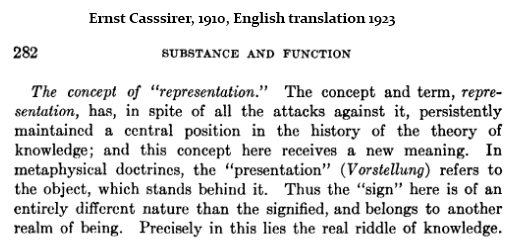The previous two posts, Baggage and The Uploading, suggest
a review of Wroclaw's native son Ernst Cassirer.
Saturday, September 17, 2011
Objectivity
Wednesday, August 10, 2011
Objectivity
From math16.com—
Quotations on Realism
|
The story of the diamond mine continues
(see Coordinated Steps and Organizing the Mine Workers)—
From The Search for Invariants (June 20, 2011):
The conclusion of Maja Lovrenov's
"The Role of Invariance in Cassirer’s Interpretation of the Theory of Relativity"—
"… physical theories prove to be theories of invariants
with regard to certain groups of transformations and
it is exactly the invariance that secures the objectivity
of a physical theory."
— SYNTHESIS PHILOSOPHICA 42 (2/2006), pp. 233–241

Related material from Sunday's New York Times travel section—
Thursday, December 27, 2012
Sunday, December 23, 2012
In a Nutshell…
The Kernel of the Concept of the Object…
according to the New York Lottery yesterday—
From 4/27
From 11/24

A page numbered 176

A page numbered 187

Wednesday, September 21, 2011
Symmetric Generation
Suggested by yesterday's Relativity Problem Revisited and by Cassirer on Objectivity—
From Symmetric Generation of Groups , by R.T. Curtis (Cambridge U. Press, 2007)—
"… we are saying much more than that
some set of seven involutions, which would be a very weak
requirement. We are asserting that M 24 is generated by a set
of seven involutions which possesses all the symmetries of
acting on the points of the 7-point projective plane…."
— Symmetric Generation , p. 41
"It turns out that this approach is particularly revealing and that
many simple groups, both sporadic and classical, have surprisingly
simple definitions of this type."
— Symmetric Generation , p. 42
See also (click to enlarge)—
Cassirer's remarks connect the concept of objectivity with that of object .
The above quotations perhaps indicate how the Mathieu group
"This is the moment which I call epiphany. First we recognise that the object is one integral thing, then we recognise that it is an organised composite structure, a thing in fact: finally, when the relation of the parts is exquisite, when the parts are adjusted to the special point, we recognise that it is that thing which it is. Its soul, its whatness, leaps to us from the vestment of its appearance. The soul of the commonest object, the structure of which is so adjusted, seems to us radiant. The object achieves its epiphany."
— James Joyce, Stephen Hero
For a simpler object "which possesses all the symmetries of
For symmetric generation of
Tuesday, June 21, 2011
Piracy Project
Recent piracy of my work as part of a London art project suggests the following.

From http://www.trussel.com/rls/rlsgb1.htm
The 2011 Long John Silver Award for academic piracy
goes to ….
Hermann Weyl, for the remark on objectivity and invariance
in his classic work Symmetry that skillfully pirated
the much earlier work of philosopher Ernst Cassirer.
And the 2011 Parrot Award for adept academic idea-lifting
goes to …
Richard Evan Schwartz of Brown University, for his
use, without citation, of Cullinane’s work illustrating
Weyl’s “relativity problem” in a finite-geometry context.
For further details, click on the above names.
Monday, June 20, 2011
The Search for Invariants
The title of a recent contribution to a London art-related "Piracy Project" begins with the phrase "The Search for Invariants."
A search for that phrase elsewhere yields a notable 1944* paper by Ernst Cassirer, "The Concept of Group and the Theory of Perception."
Page 20: "It is a process of objectification, the characteristic nature
and tendency of which finds expression in the formation of invariants."
Cassirer's concepts seem related to Weyl's famous remark that
“Objectivity means invariance with respect to the group of automorphisms.”
—Symmetry (Princeton University Press, 1952, page 132)
See also this journal on June 23, 2010— "Group Theory and Philosophy"— as well as some Math Forum remarks on Cassirer and Weyl.
Update of 6 to 7:50 PM June 20, 2011—
Weyl's 1952 remark seems to echo remarks in 1910 and 1921 by Cassirer.
See Cassirer in 1910 and 1921 on Objectivity.
Another source on Cassirer, invariance, and objectivity—
The conclusion of Maja Lovrenov's
"The Role of Invariance in Cassirer’s Interpretation of the Theory of Relativity"—
"… physical theories prove to be theories of invariants
with regard to certain groups of transformations and
it is exactly the invariance that secures the objectivity
of a physical theory."
— SYNTHESIS PHILOSOPHICA 42 (2/2006), pp. 233–241
A search in Weyl's Symmetry for any reference to Ernst Cassirer yields no results.
* Published in French in 1938.



